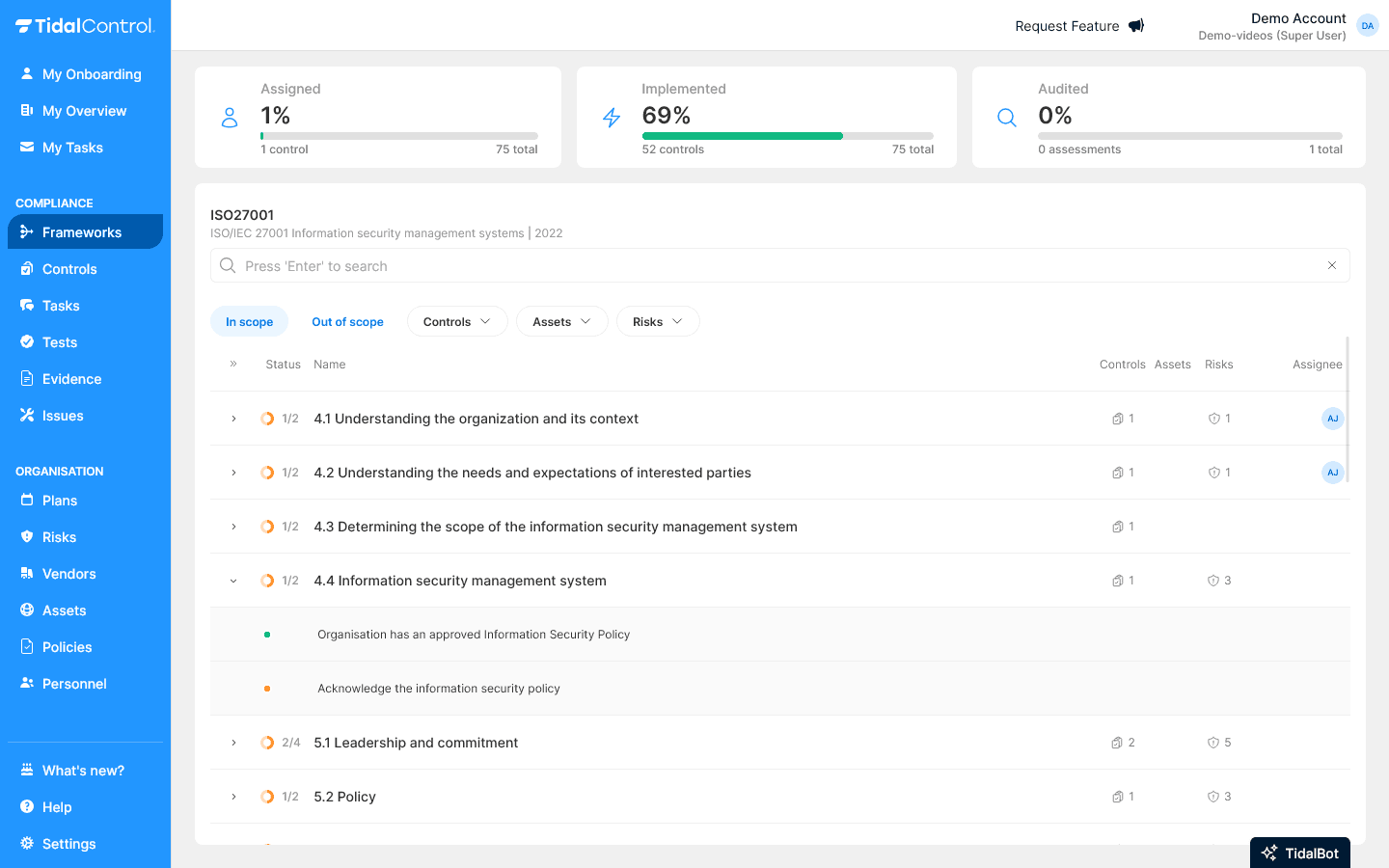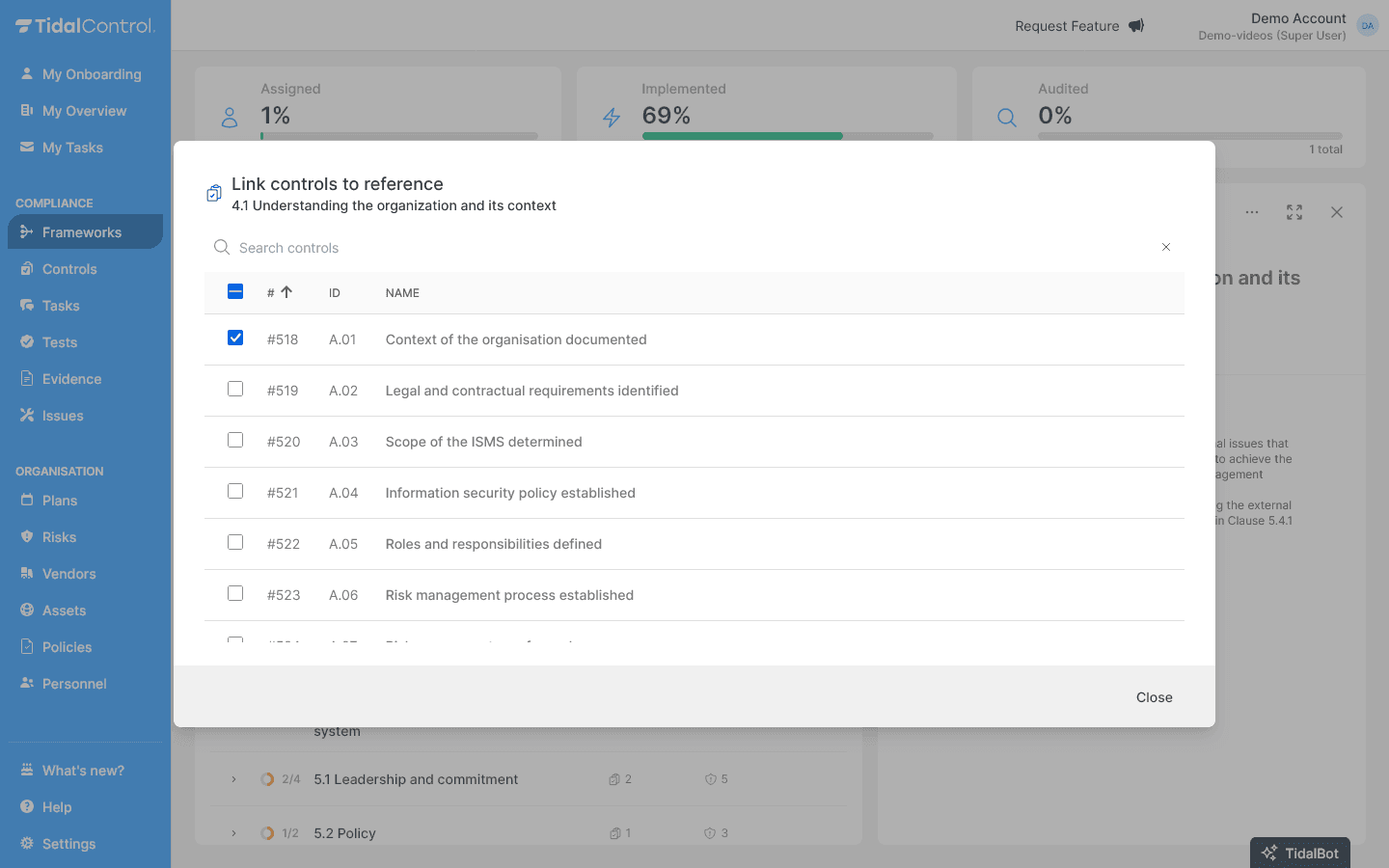Frameworks
Activating frameworks and linking controls
Activating frameworks
Your license on the Tidal platform is linked to one or more frameworks. These frameworks have already been activated by Tidal, including the mapping between framework requirements and applicable controls.
Contact support if frameworks you have a license for are showing as inactive in Tidal.
From inactive to active
A framework becomes automatically active as soon as you link at least one control to a framework requirement. This is the first crucial step toward a working compliance setup.
Activation process:
- Click "Start" button on a gray (inactive) framework tile
- Framework detail page opens with all framework requirements
- Explore the framework structure and identify priorities
- Link first control to a requirement to complete activation

Exploring framework requirements
Understanding structure:
- Numbered sections - For example 4.1, 4.2, 4.3 for ISO 27001
- Section titles - "Understanding the organization and its context"
- Individual requirements - Specific requirements per section
- Expandable sections - Click arrow to show requirements
Framework navigation tips:
- Start with section 4.1 - Often the fundamental organizational context
- Look for quick wins - Simple requirements you can address quickly
- Identify dependencies - Which requirements build on each other
- Plan implementation order - Logical progression through the framework
Strategic start: Begin with organizational requirements (context, scope, policy) before moving to technical implementations. This provides a solid foundation for the rest of the framework.
Understanding the progress dashboard
Interpreting progress indicators
Once your framework is active, the dashboard shows three critical percentages that represent your compliance status.

Assigned:
- Percentage of controls with owners assigned
- Team responsibility - Who does what
- Prerequisite for - assigning (recurring) tasks
- Goal: 100% before sending tasks according to Plans
Implemented:
- Percentage of controls with all tasks and tests completed
- Actual implementation - Controls are operational
- Prerequisite for - demonstrating presence and implementation of measures
- Goal: 100% before starting internal audit
Audited:
- Percentage of completed assessment tasks for linked controls
- Effectiveness verification - Controls work as intended
- Prerequisite for - demonstrating conducted internal audit
- Goal: At least 100% before starting certification audit
Linking controls
"Link Control" functionality
The most efficient way to meet framework requirements is by reusing existing controls. This maximizes your "test once, use often" advantage.
Control linking steps:
- Click "Link Control" button to the right of a framework requirement
- Control search dialog opens with all available controls
- Search and select relevant controls
- Confirm linking and check result

"Add Control" workflow
If no suitable existing control is available, you can directly create a new control and link it to the framework requirement.
Creating new control:
- Click "Add Control" button to the right of a framework requirement
- Control creation dialog opens
- Fill in control information
- Control is automatically linked to the requirement

Filling in control information
Required fields:
- Name - Clear, descriptive name for the control
- For example: "Information security policy is established and maintained"
Optional but recommended fields:
- Custom ID - Own identification number for internal reference
- Assign owner - Direct owner assignment for new control
- Description - Detailed explanation of control purpose and implementation
Control naming best practices:
- Result-oriented - Start with the result the control aims to achieve
- Specific and measurable - Clear what exactly needs to happen
- Consistent formatting - Follow organizational conventions
- Future-proof - Names that remain accurate with framework updates
Examples of good control names:
✓ "Access rights are reviewed and updated"
✓ "Backup procedures are tested"
✓ "Incident response plan developed and up to date"
✗ "Access control" (too general)
✗ "Monitoring" (unclear what is monitored)
✗ "Security stuff" (not professional)
Unlinking controls
For unlinking framework requirements and existing controls, without deleting the controls.
"Unlink Control" functionality:
- Select the control(s) you want to unlink
- Click the newly appeared "Unlink Control" button next to a linked control
- Controls remain but are no longer linked to framework requirement
- Progress percentages are automatically updated

Next steps
Now that you know how to activate frameworks and link controls:
- Start with one priority framework relevant to your organization
- Contact us if you want to use Tidal mappings
- Map the remaining controls yourself for maximum reuse efficiency
- Monitor progress systematically via dashboard indicators
- Previous
- Getting started with Frameworks